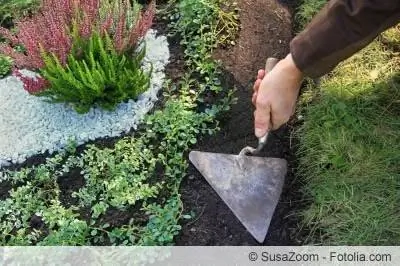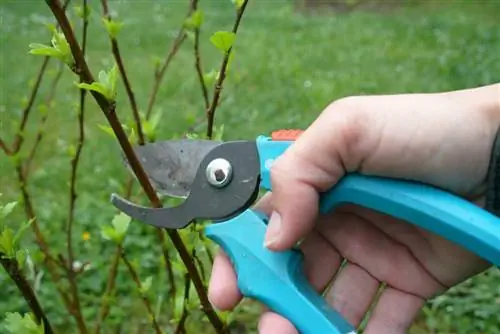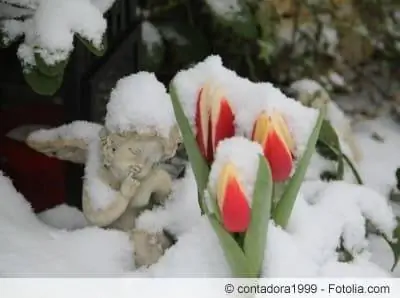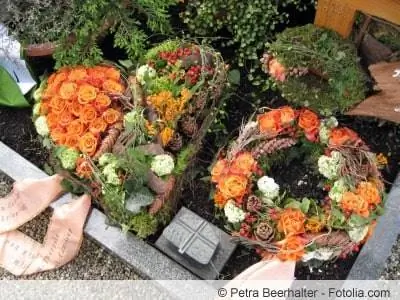- Author admin [email protected].
- Public 2023-12-17 03:39.
- Last modified 2025-01-24 12:45.
When the mild October sun bathes the grave in golden light, this is the ideal time for autumn planting. The plants will quickly take root in the sun-warmed soil to give their best in time for the high holidays on All Saints' Day and Sunday of the Dead. With a clever selection of species and varieties, the resting place offers a well-kept appearance well into spring, as a worthy setting for commemorating the deceased. The following ideas for cemetery planting may serve as inspiration for a harmonious grave design.
Magnificent autumn bloomers
The classic autumn bloomers quickly transform the grave into a sea of flowers. Various species and varieties bravely brave even the first frosts and drive away any growing sadness in the dark weeks of November and December. The following overview presents popular examples:
Cushion Aster (Aster dumosus)
This autumn bloomer enchants with rich flowers in every conceivable shade of pink, close together along richly branched inflorescences. The pretty foliage decoratively underlines the splendor of the flowers and also serves as leaf decoration when the flowers have withered.
- Growth height 35-40 cm
- Flowering from September to October
Autumn Chrysanthemum (Chrysanthemum Indicum)
The traditional flowers for funeral floristry in arrangements and bouquets include the large-growing chrysanthemum varieties. A look of remarkable harmony is created when the unmistakable flower shape is repeated as a bedding plant. The autumn chrysanthemum appears immediately after the autumn aster, so that an uninterrupted bloom of flowers welcomes visitors to the resting place. The variety of colors ranges from subtle white to bright orange to bronze yellow.
- Growth height 60-70 cm
- Flowering from October to November

Pansies (Viola)
The busy floral wonders are an integral part of creative cemetery planting. The more than 400 species include hundreds of varieties with large or small flowers in diverse colors. It is the small-flowered violets in particular that are the first to welcome spring thanks to their winter hardiness.
- Growth height 10-20 cm
- Flowering from February to December
Autumn cyclamen (Cyclamen hederifolium)
The ivy-leaved cyclamen impresses with its opulent blooms until November. It does not lose its attractiveness throughout the winter thanks to the marked, triangular leaves. An ideal candidate for long-lasting grave planting during the cold season.
- Growth height 10-15 cm
- Flowering from August/September to October/November
Tip:
A weed fleece - spread out between the topsoil and grave soil - reliably prevents annoying weeds from spreading on the grave in the mild winter.
Splash of color in winter
If you integrate bud bloomers into your autumn cemetery planting, pretty splashes of color are guaranteed all winter long, because they can withstand temperatures down to -15 degrees Celsius. In addition, fruit ornamental plants that do not miss a flower are also available.
Broom heather (Calluna vulgaris)
The small, evergreen heather from the erica family does not open its flowers completely. Rather, it is their bright buds that provide colorful focal points. The flower color in purple to purple-rosé harmonizes wonderfully with the subtle colors of traditional grave arrangements.
- Growth height 15 to 40 cm
- Flowering from October to February

Winter heather (Erica darleyensis)
The ideal planting for a grave in a nutrient-poor location, because winter heather blooms in wonderful white or graceful pink without making any great demands. Even calcareous soil does not cause any problems for the grateful heather plant.
- Growth height 30-40 cm
- Flowering from December to March
Partridgeberry (Gaultheria procumbens)
This decorative dwarf shrub impresses with its dark green foliage and bright red berries in autumn. The eye-catching fruit decoration lasts until spring as long as hungry birds don't peck at it. While the carpet berry stands out as an enchanting ground cover in the large garden, it comes into its own as a solitary plant on a single or urn grave or in a small group on a double grave.
- Growth height up to 20 cm
- Pink flowers in July and August
Evergreen Grave Companions
They symbolize strength and eternal life. Evergreen plants are considered an indispensable part of creative grave planting. Some of the following species have proven successful in fulfilling this task for generations.
Blue Carpet Juniper (Juniperus horizontalis 'Glauca')
A gem within the large Juniperus family with its shimmering steel blue, delicately leafed branches. At first glance, you won't notice this decorative juniper's robust constitution. In fact, it won't let you down at any time during the winter. In addition, the conifer is an excellent problem solver if you are considering planting large areas of the grave area due to a lack of time.
- Growth height 20-30 cm
- Completely hardy
Rape myrtle (Leucothoe 'Scarletta')
This impressive dwarf shrub will make a name for itself in cemetery planting. As autumn progresses, its fresh green leaves take on a reddish-bronze color that attracts everyone's attention. Towards spring the color deepens into a rich scarlet red.
- Growth height 20-30 cm
- White flowers from May to June

Ground cover cherry laurel (Prunus laurocerasus 'Mount Vernon')
While its big brother overtakes conifers as a hedge plant, the small ground cover cherry laurel is useful as an elegant grave plant. Planted as a solitaire in autumn, the shiny green foliage remains intact through frost and snow.
- Growth height 15-30 cm
- No flowers
Native wild perennials
Tradition and symbolism are particularly expressed in a resting place when native perennials are used in the planting plan. At the same time, you demonstrate a profound connection to your homeland, which in no way runs counter to modern trends in grave design. As a practical side effect, you can plant plants in the cemetery that do not constantly require care.
- Round-leaved bellflower (Campanula rotundifolia) with blue-violet flowers until October
- Scabious knapweed (Centaurea scabiosa), the ideal planting for new graves
- Meadow cranesbill (Geranium pratense), blooms again after pruning in September
- Mouse ear (Hieracium pilosella), with a height of 20 cm nice for the urn grave
- Field scabious (Knautia arvensis), with decorative flowers until September
- Scented violet (Viola odorata), the robust wild form of the popular pansy
This is just a small selection from the cornucopia of enchanting wildflowers that reflect the power of Mother Nature as grave plantings.
Perennials with a decorative winter silhouette
When the sun's rays become scarce in winter, plants that provide decorative structures thanks to their stability become more important. A perennial covered with hoarfrost and snowcaps creates a comforting aura in the winter resting place. The following species and varieties deserve attention from this aspect:
Yarrow (Achillea filipendulina)
It is robust, stable and vigorous. The plate-shaped inflorescences should not be cut off as they are used for winter decoration.
- Growth height up to 60 cm
- Ideal for sunny locations
Prairie beardgrass (Andropogon scoparius)
The tightly upright to elegantly curved ornamental grass takes on a subtle brown tone in autumn, which turns into straw yellow. The valuable grass retains its silhouette even under a thick blanket of snow and at the same time proves to be extremely drought-tolerant. The prairie beard grass also cuts a fine figure in the autumn grave bowl.
- Growth height up to 50 cm
- Flowering from September to October

Ball Thistle (Echinops ritro)
The spherical flowering ends in October at the latest, although the spent inflorescences remain on the plant and are not harvested until the next spring. Covered with freezing rain, the globe thistle transforms into a glittering eye-catcher on the grave.
- Growth height 50-80 cm
- No thorns on the variety 'Veitch's Blue'
Sedum 'Autumn Joy' (Sedum Telephium hybrid 'Autumn Joy')
Saving the best for last. With this sedum you get a breathtaking autumn bloomer with flat, arched inflorescences in a wonderful rusty red. The long list of convincing attributes ranges from location-tolerant to easy-care to long-lasting. In winter, the sedum plant presents a lush silhouette as the snowflakes gather on the withered flowers.
- Growth height 50-70 cm
- Flowering from September to October
Conclusion
For successful grave planting in autumn, the focus is on plants that, on the one hand, provide the last blossom of the year and, on the other hand, defy the rigors of winter. Aspects such as tradition, mythology and symbolism also play a role. Creative ideas can be realized with classics such as autumn asters, chrysanthemums and pansies. If evergreen grave companions are added, such as the carpet juniper, the resting place offers a well-kept appearance even in the harshest winter. The creative arrangement is rounded off by native wildflowers and perennials with a shapely silhouette under the snow and ice.






